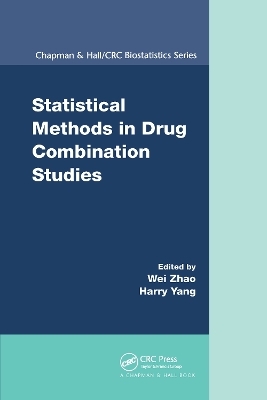
Statistical Methods in Drug Combination Studies
Seiten
2020
Chapman & Hall/CRC (Verlag)
978-0-367-73862-4 (ISBN)
Chapman & Hall/CRC (Verlag)
978-0-367-73862-4 (ISBN)
This comprehensive reference covers all aspects of drug combination research, from designing in vitro drug combination studies to analyzing clinical trial data. Featuring contributions from researchers in industry, academia, and regulatory agencies, this balanced text provides researchers with a solid understanding of the available statis
The growing interest in using combination drugs to treat various complex diseases has spawned the development of many novel statistical methodologies. The theoretical development, coupled with advances in statistical computing, makes it possible to apply these emerging statistical methods in in vitro and in vivo drug combination assessments. However, despite these advances, no book has served as a single source of information for statistical methods in drug combination research, nor has there been any guidance for experimental strategies.
Statistical Methods in Drug Combination Studies fills that gap, covering all aspects of drug combination research, from designing in vitro drug combination studies to analyzing clinical trial data. Featuring contributions from researchers in industry, academia, and regulatory agencies, this comprehensive reference:
Describes statistical models used to characterize dose–response patterns of monotherapies and evaluate the combination drug synergy
Offers guidance for estimating interaction indices and constructing their associated confidence intervals to assess drug interaction
Introduces a practical and innovative Bayesian approach to Phase I cancer trials, including actual trial examples to illustrate use
Examines strategies in the fixed-dose combination therapy clinical development via case studies stemming from regulatory reviews
Evaluates computational tools and software packages used to apply novel statistical methods in combination drug development
Statistical Methods in Drug Combination Studies provides researchers with a solid understanding of the available statistical methods and computational tools and how to apply them in drug combination studies. The book is equally useful for statisticians to become better equipped to deal with drug combination study design and analysis in their practice.
The growing interest in using combination drugs to treat various complex diseases has spawned the development of many novel statistical methodologies. The theoretical development, coupled with advances in statistical computing, makes it possible to apply these emerging statistical methods in in vitro and in vivo drug combination assessments. However, despite these advances, no book has served as a single source of information for statistical methods in drug combination research, nor has there been any guidance for experimental strategies.
Statistical Methods in Drug Combination Studies fills that gap, covering all aspects of drug combination research, from designing in vitro drug combination studies to analyzing clinical trial data. Featuring contributions from researchers in industry, academia, and regulatory agencies, this comprehensive reference:
Describes statistical models used to characterize dose–response patterns of monotherapies and evaluate the combination drug synergy
Offers guidance for estimating interaction indices and constructing their associated confidence intervals to assess drug interaction
Introduces a practical and innovative Bayesian approach to Phase I cancer trials, including actual trial examples to illustrate use
Examines strategies in the fixed-dose combination therapy clinical development via case studies stemming from regulatory reviews
Evaluates computational tools and software packages used to apply novel statistical methods in combination drug development
Statistical Methods in Drug Combination Studies provides researchers with a solid understanding of the available statistical methods and computational tools and how to apply them in drug combination studies. The book is equally useful for statisticians to become better equipped to deal with drug combination study design and analysis in their practice.
Wei Zhao, Harry Yang
Drug Combination: Much Promise and Many Hurdles. Drug Combination Synergy. Drug Combination Design Strategies. Confidence Interval for Interaction Index. Two-Stage Response Surface Approaches to Modeling Drug Interaction. A Bayesian Industry Approach to Phase I Combination Trials in Oncology. Statistical Methodology for Evaluating Combination Therapy in Clinical Trials. Challenges and Opportunities in Analysis of Drug Combination Clinical Trial Data. Software and Tools to Analyze Drug Combination Data.
| Erscheinungsdatum | 16.01.2021 |
|---|---|
| Reihe/Serie | Chapman & Hall/CRC Biostatistics Series |
| Sprache | englisch |
| Maße | 156 x 234 mm |
| Gewicht | 453 g |
| Themenwelt | Mathematik / Informatik ► Mathematik ► Statistik |
| Medizin / Pharmazie ► Medizinische Fachgebiete ► Pharmakologie / Pharmakotherapie | |
| Naturwissenschaften ► Biologie | |
| Technik | |
| ISBN-10 | 0-367-73862-7 / 0367738627 |
| ISBN-13 | 978-0-367-73862-4 / 9780367738624 |
| Zustand | Neuware |
| Haben Sie eine Frage zum Produkt? |
Mehr entdecken
aus dem Bereich
aus dem Bereich
Eine Einführung für Wirtschafts- und Sozialwissenschaftler
Buch | Softcover (2022)
De Gruyter Oldenbourg (Verlag)
29,95 €


